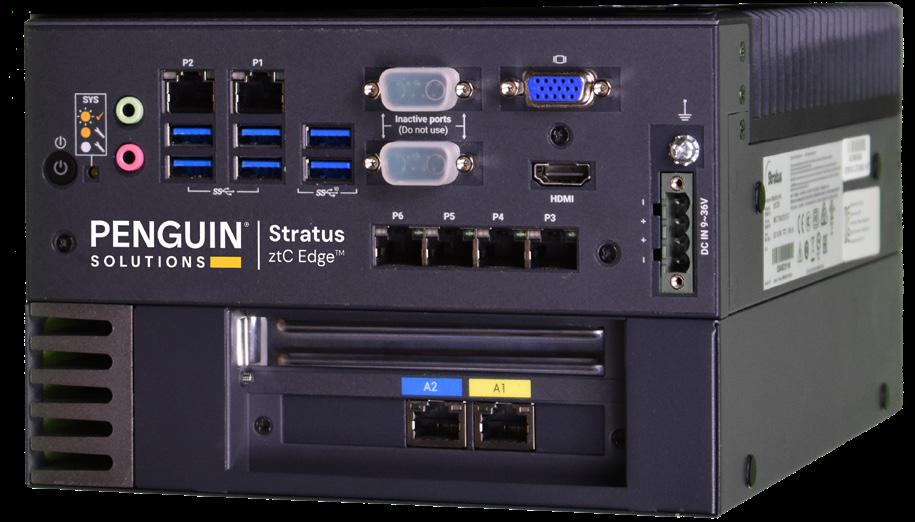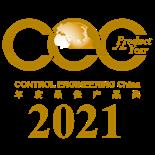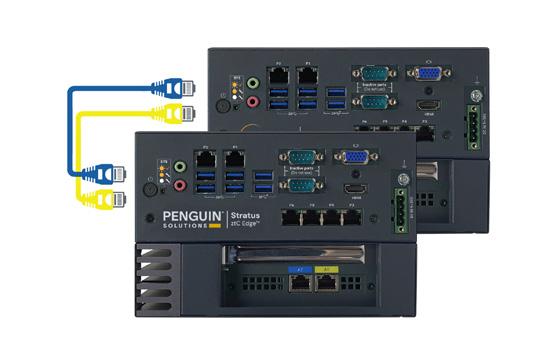
Datasheet


Datasheet

Zero-touch edge computing for up to 10,000 input-output operations (I/Os) in pharma manufacturing, food & beverage, specialty chemicals, oil & gas, and other industrial verticals.
Overview
As Internet-connected devices generate more and more data for processing at edge locations, companies need to be sure that their computing infrastructure is up to the task. Penguin Solutions® Stratus ztC EdgeTM makes advanced computing infrastructure simple to deploy and manage, autonomous to operate, and protected against data loss, environmental risks, and cyber threats.
The Stratus ztC Edge is a secure, rugged, highly automated computing platform that helps understaffed organizations improve productivity, increase operational efficiency, and reduce downtime risk at the edge of their networks. Designed for both operational technology (OT) and information technology (IT) teams, it is easy to deploy, secure, manage (whether locally or remotely), maintain, and service.
Self-monitoring, self-protecting, and self-synchronizing, Stratus ztC Edge saves companies time and money. With built-in virtualization, automated protection, durable industrial interoperability, OT manageability, and field serviceability, Stratus ztC Edge supports efficient delivery of highly available and fault-tolerant virtualized edge applications.








• Greater efficiency: Built-in virtualization supporting Windows and Linux guest operating systems, industrial interoperability, and field serviceability to streamline the deployment, management, and maintenance of critical edge applications.
• Simplified security: Restricted USB ports, secure communication protocols, trusted boot, role-based access controls, and a configurable host-based firewall, makes it easy to secure your platform.
• Less downtime: Self-monitoring and selfprotecting features help reduce unplanned downtime. With the ability to update its operating environment without rebooting, it also reduces planned downtime.
• More flexibility: Stratus ztC Edge’s rugged, compact, industrial design performs equally in control rooms, panels, shop floors, or inside machines, giving customers more choice. Its automated capabilities make it ideal for remote or unmanned sites with limited IT support.
• Autonomous Simplified management: RESTful application programming interface (API) available in the Stratus ztC Edge offers interoperability with your preferred system management tools.
Stratus ztC Edge enables the rapid and efficient delivery of reliable business-critical applications in remote, understaffed locations at the edge of networks. With built-in virtualization, simplified security, industrial interoperability, OT manageability, rugged form factor, automated protection, field serviceability, and complementary services, Stratus ztC Edge helps companies boost productivity while minimizing risk of downtime.
Stratus ztC Edge is designed to help OT and IT teams more easily secure their edge computing environment. A host-based firewall, restricted USB ports, role-based access controls with Active Directory integration, secure communications protocols, and secure and trusted boot all work together to minimize your security exposure.
Stratus ztC Edge ships with its own management tool, the Stratus ztC Edge Console, that simplifies system and software management. With it, administrators can remotely access systems, set thresholds and alerts, check for updates, backup and restore system settings and preferences, and manage their VMs with ease. Administrators can also leverage Stratus ztC Edge’s RESTful API calls to enable interoperability with third-party system management tools, enabling local or remote monitoring and management on a single pane of glass.
Rugged redundant nodes
Designed for the harsh conditions typically found in industrial locations, Stratus ztC Edge nodes are UL Class I Div 2 certified and IP40-rated for deployment anywhere from the control room or control panel to machines on the shopfloor, closer to your devices that are generating data. More durable than standard servers or workstations, Stratus ztC Edge offers customers greater reliability and more flexibility in deployment.
When deployed as a redundant pair, Stratus ztC Edge 250i platforms are hot-swappable and auto-synchronizing, making field repairs quick and easy. Maintenance and repairs to individual computers can be completed while the node is running without a system reboot. This ensures service continuity and allows OT or IT staff to plan and complete system repairs when most convenient.
When deployed as a redundant pair (dual deployment), Stratus ztC Edge provides instant protection for your workloads. Data is automatically replicated across platforms and VMs running on one platform will automatically restart (if in High Availability mode) or resume on the other machine (if in Fault-Tolerant mode) in the event of a failure. If Stratus ztC Edge detects a networking or disk failure on one computer, it re-routes traffic or uses data on the other computer automatically, with no operator intervention. Platforms can even be deployed across physical distances for automated local site recovery.
Industrial interoperability
Stratus ztC Edge supports common OT and IT protocols, which simplifies integration into existing industrial automation environments. SNMP requests and traps can be used to configure notifications and alarms. Customers can also use OPC Unified Architecture (OPC UA) attributes or a RESTful API to present relevant system data within most third-party system management tools and dashboards.
Built-in virtualization
Stratus ztC Edge ships with its own operating environment called Stratus Redundant Linux. It contains a virtualization host that supports both Windows and Linux guest operating systems, Open Virtualization Format (OVF) files, and Open Virtual Appliance (OVA) images (including third-party templates). An intuitive management console makes it easy for local and remote staff to set up, configure, import, and manage their virtual machines (VMs).
High availability configuration

In-flight data Stored data
In-flight data Stored data
Fault tolerant configuration

In-flight data Stored data
In-flight data Stored data
100111001101 001100101010101000101100 101100100111 100100111010011100010011
100111001101 001100101010 1 01000101100 101100100111100100111010011100010011 Primary node fails* Failover
node restart VMs
100111001101 001100101010101000101100 101100100111 100100111010011100010011
100111001101001100101010101000101100 101100100111100100111010011100010011
or
Penguin Solutions provides a single source of support for complex interrelated hardware, software, and operating system issues. Complementary services available with Status ztC Edge include Penguin Solutions System Support, System Health Add-ons, and Managed Support Services, which together ensure critical workloads can continue to run with minimal customer effort.
Penguin Solutions industry-leading zero-touch edge computing platforms backed by Penguin Solutions Support Services deliver the most reliable—and supported—edge infrastructure solutions so that you can focus 100% of your time on operations.
• 9x5 web-based support for 30-minute response service-level agreement (SLA) for critical severity cases
• Root cause problem determination
• Software updates and upgrades
• Secure access to self-service portal
• 24x7x365 web and phone support for critical severity cases with 30-minute response SLA
• Advanced parts exchange
• Proactive uptime monitoring
- Alert triage (optional)
- System log file review
- Predictive failure analysis
• Media retention
System Support
Stratus ztC Edge 250i
Compute Intel Xeon W-1290TE, 1.8 GHz, 20 MB cache, 10 HT cores
Memory 64 GB DDR4 2666 MHz (ECC)
Storage 2 TB SSD (NVMe)
Networking
2 x 10 GbE (for a-links) 6 x 1 GbE (for networks)
Operating Temperature1 –20 to 60°C (–4 to 140 °F)
Humidity 95% @ 40°C (non-condensing)
Shock and vibration 10G, 11 ms 1.5 Grms @ 5 – 500 Hz
Input power 2 9V - 36V (DC)
Dimensions 230 x 192 x 127 mm (9.1 x 7.6 x 5.0 in)
Weight 4.6 kg (10.2 lbs)
Availability support Fault tolerance and high availability
Certifications3 CI D2, FCC, CE, and others3
Host OS support4 Stratus Redundant Linux4
Guest OS support5 Windows and Linux5
1. Operating temperature ranges listed are for DC power. When AC power is used (using an optional AC Adapter), the recommended range for the Stratus ztC Edge 250i is 0 to 50°C (32 to 122°F).
2. An optional AC Adapter (100-240V, 2.5A, 50-60Hz) may also be used.
3. https://www.stratus.com/services-support/customer-support/#ztc-edge
4. https://www.stratus.com/services-support/downloads/?tab=ztcedge
5. https://www.stratus.com/services-support/customer-support/platform-support/ztc-edge-guest-operating-system-support/
Additionally, Penguin Solutions offers Stratus ztC Endurance™, which enables organizations to run critical applications without downtime or data loss in both edge and data center environments. The platform protects critical applications and data using intelligent, predictive fault tolerance based on Penguin Solutions proven redundant hardware architecture, hardened drivers, and Stratus Automated Uptime Layer with Smart Exchange™ combined with Intel RAS technology and embedded security features. For more information about Stratus ztC Endurance, please visit https://www.penguinsolutions.com/en-us/products/stratus-ztc-endurance
Penguin Solutions also offers Stratus ftServer®, a rack-mounted fault-tolerant server that is designed to run larger-scale tier-one mission-critical workloads. Supporting 30+ VMs, Stratus ftServer delivers continuously available manufacturing operations and centralized control applications. For more information about Stratus ftServer, please visit https://www.penguinsolutions.com/en-us/products/stratus-ftserver
For sales queries, please contact sales@penguinsolutions.com
To learn more about Stratus ztC Edge and other Penguin Solutions products, please visit: www.penguinsolutions.com